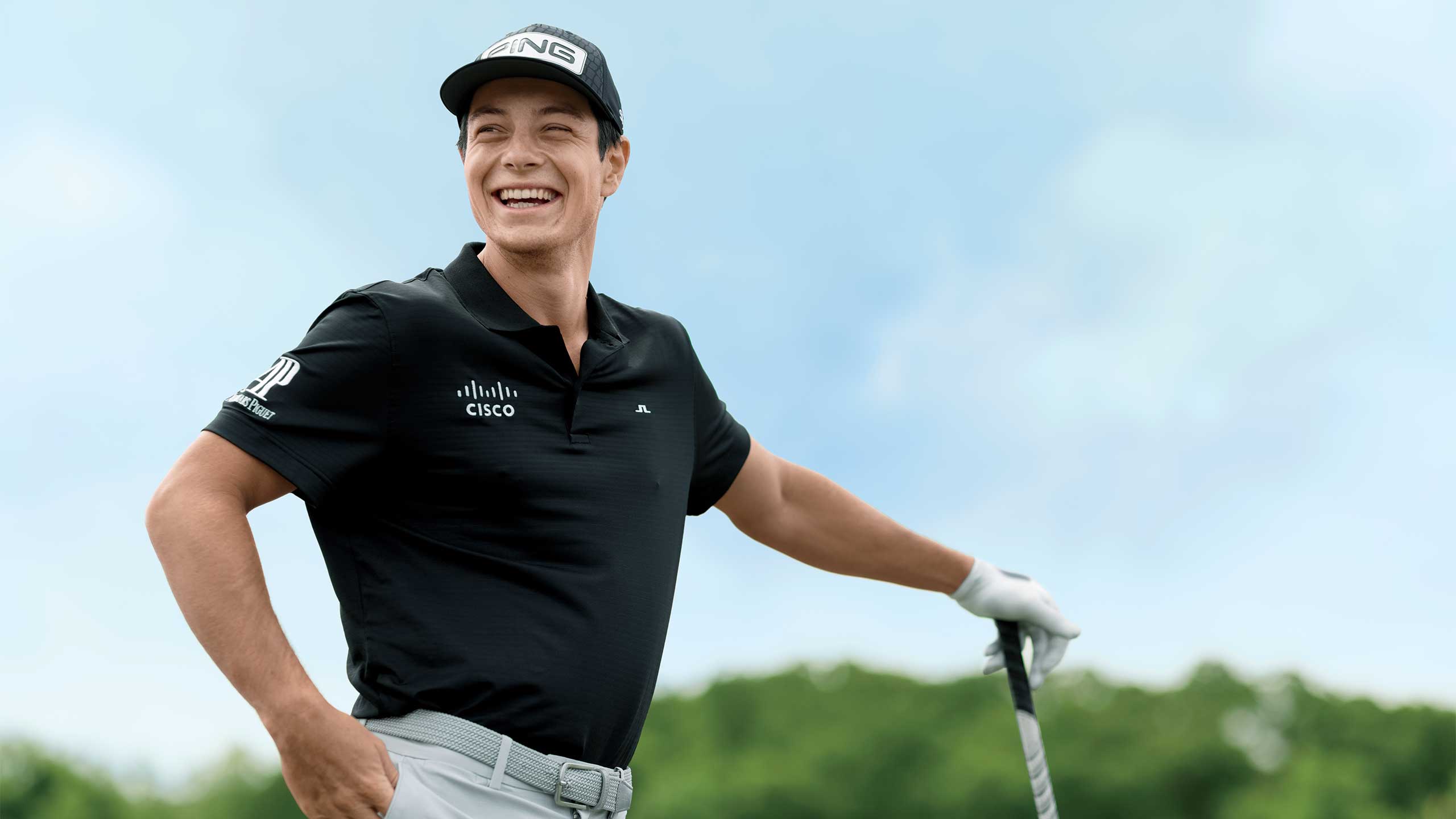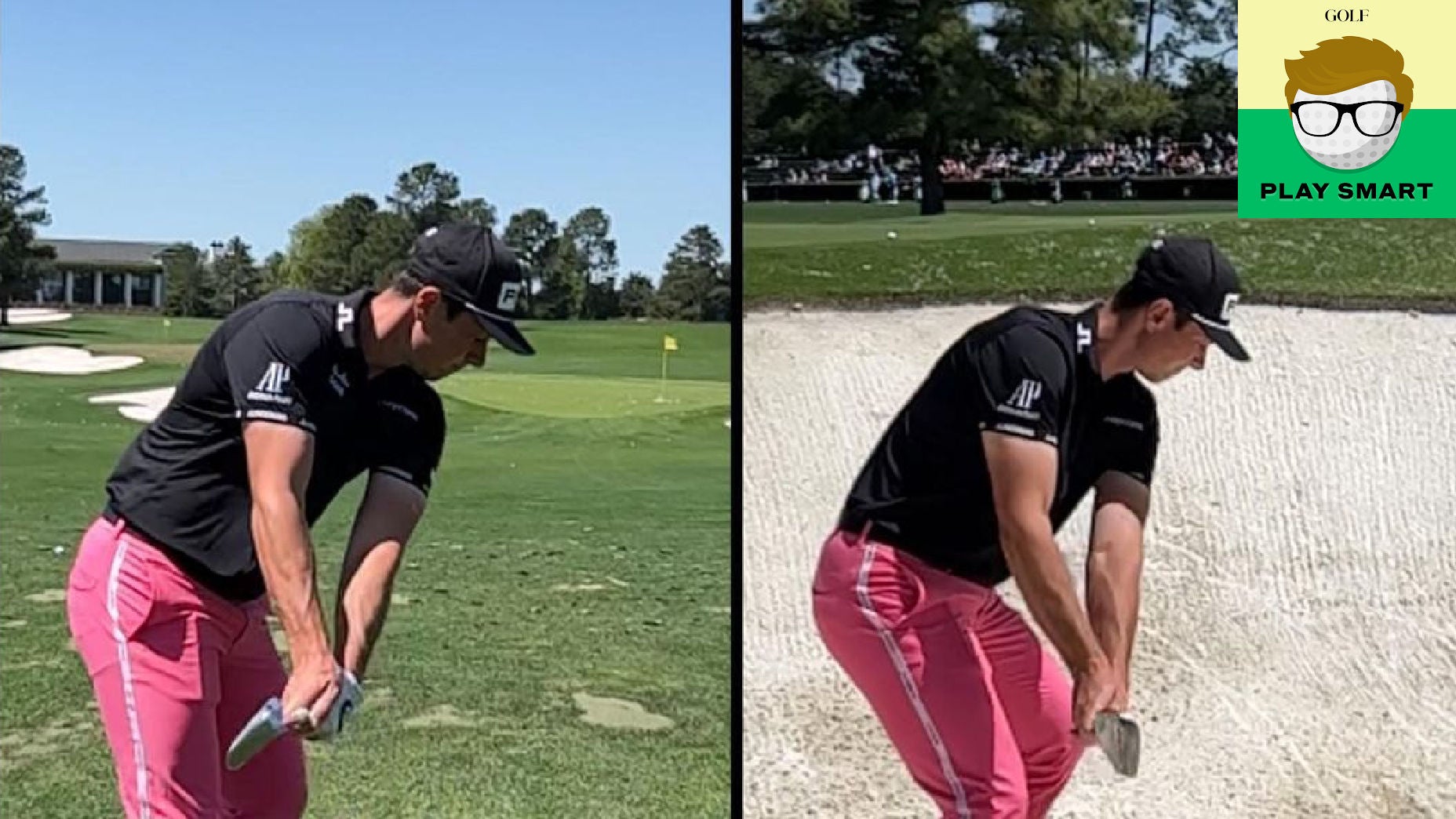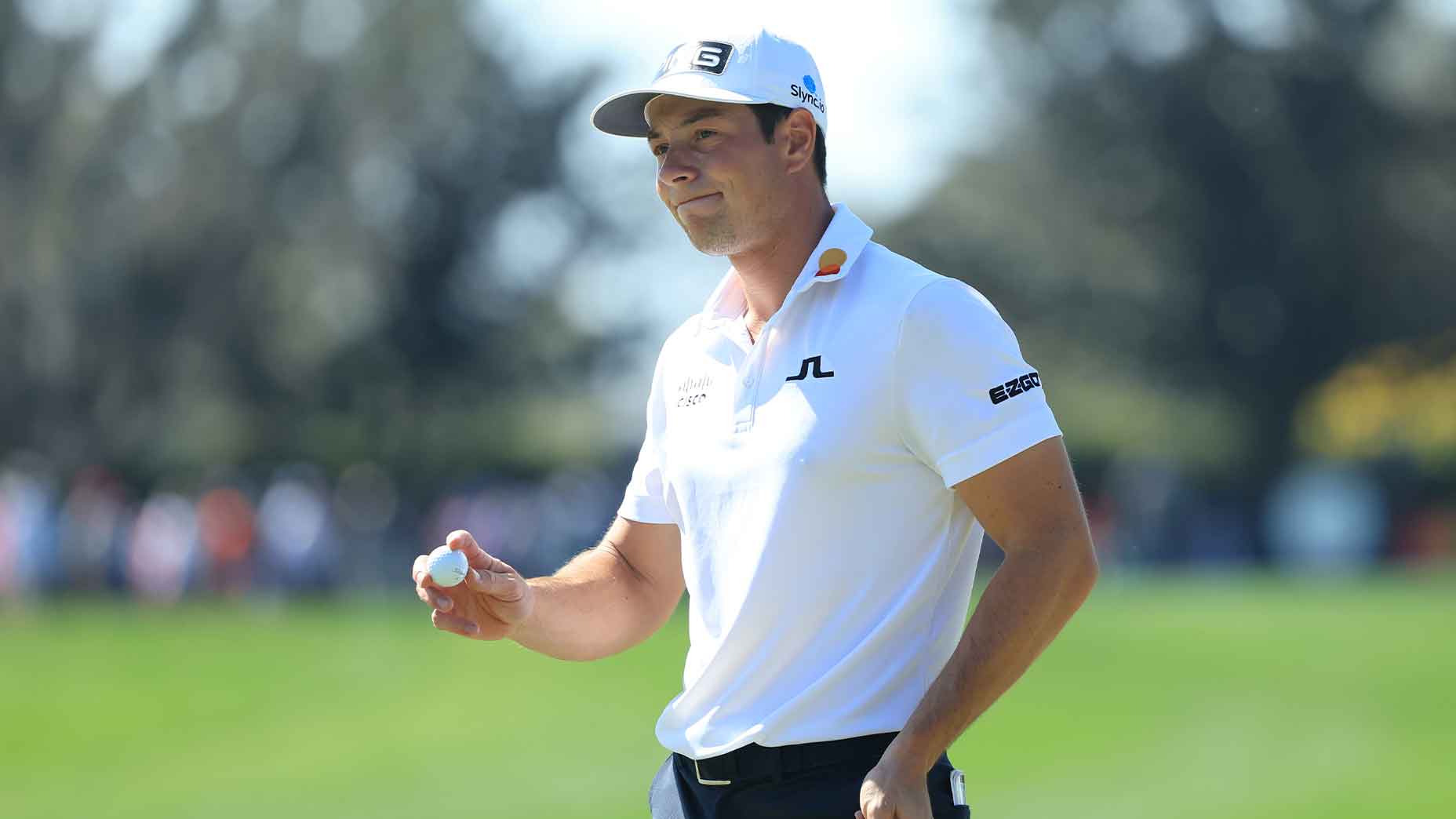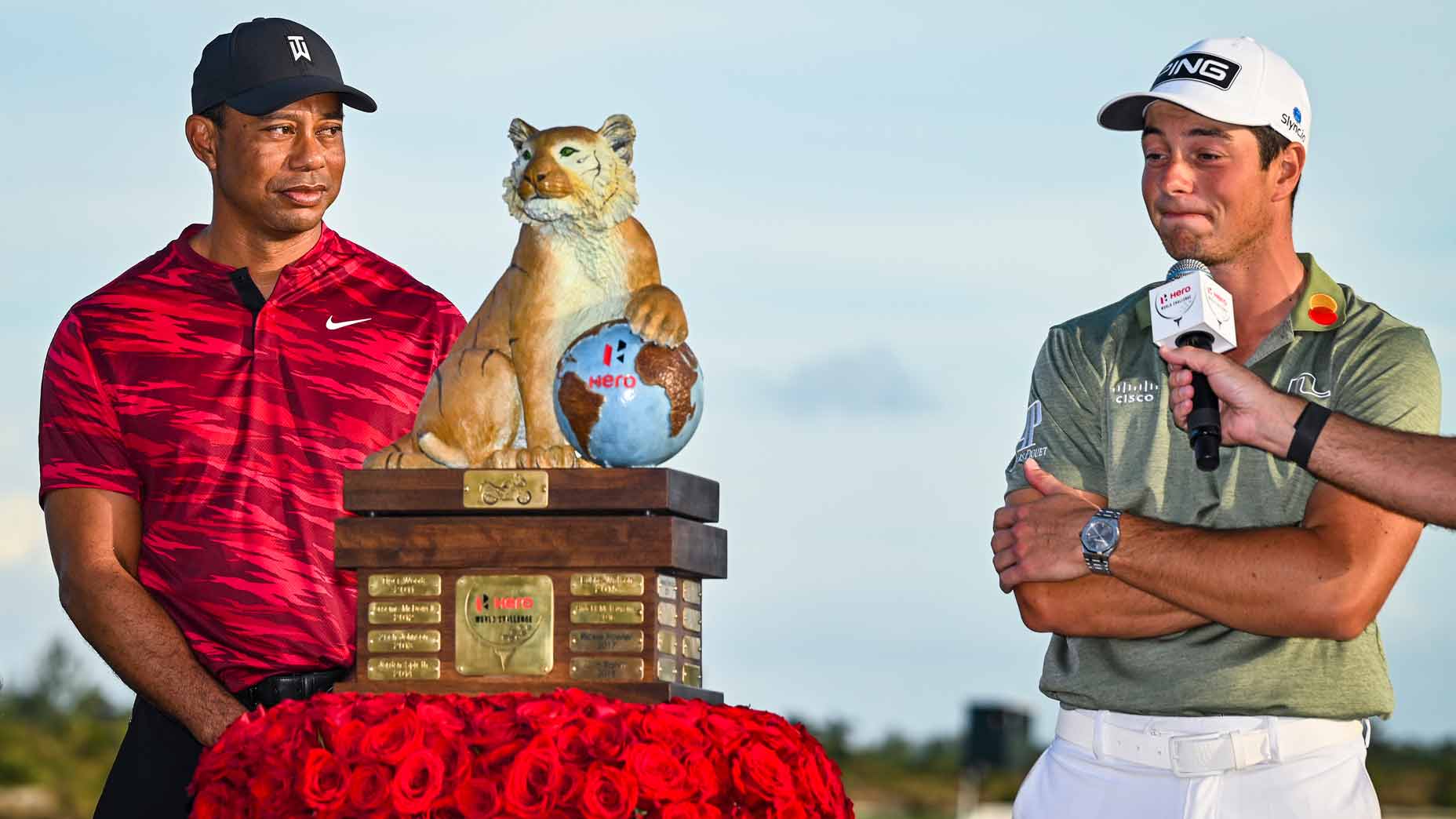It’s a quiet afternoon in Stillwater, Oklahoma, but not inside Viktor Hovland’s car. Cruising through the college town that he has made his home, Hovland has his playlist on shuffle and the volume cranked up ear-bleed loud. A demonic howl fills the cabin of his cloud-white Lexus, backed by frenzied drumming and distorted guitar. Hovland nods and grins amid the din, the same impish expression he’s known for on the course.
“I have no idea what the singer is saying,” he says, raising his voice to be heard. “But it all sounds great to me.”
The song, by a band called Karmanjakah, is progressive metal, mellow in comparison to death metal, a popular genre in Hovland’s native Norway, but also a far cry from country and western, perhaps the only staple of life in Stillwater that Hovland hasn’t managed to embrace.
“I just can’t go there,” he says.
Most everything else seems to suit him fine: the unhurried pace, the open spaces, the lingering ties to friends and former teammates at golf-powerhouse Oklahoma State, where Hovland was enrolled when he won the 2018 U.S. Amateur and NCAA team titles. In 2019, after finishing as low-am in the Masters and the U.S. Open, the would-be college senior turned pro, missing out on a degree but earning his Tour card and nabbing two titles in his first season, clinching each with long, cold-blooded putts. That was 2020. In December of that year, he turned 23.
As a member of a rookie class that included teammate Matthew Wolff, and the latest in a long line of Cowboy talent highlighted by the likes of Bob Tway, Scott Verplank and Rickie Fowler, Hovland might have followed a familiar Tour-pro blueprint by relocating to Jupiter or Scottsdale. Instead, he doubled down on Stillwater, buying a house in town and inviting two college golf buddies to live with him.
It was a nonconformist but on-brand move for Hovland, who tends to keep convention at arm’s length. As with his swing, an unorthodox pass he patterned partly on obscure YouTube teachings, there was clear thinking behind it. The house is close to campus and even closer to Karsten Creek Golf Club, the Cowboys’ home course, whose namesake and benefactor, Ping founder Karsten Solheim, was also Norwegian born. Staying put was a stabilizing move for Hovland in a time of flux, and an antidote to the hotel-loneliness of the Tour.
“I figured I was already making enough adjustments,” he says. “I wanted to keep some other important things the same.”

Inside the Lexus, a new aural assault is raging: “Insects” by the death-metal duo Darko US. It sounds like someone grinding a 9-iron in a blender, though that’s not how Hovland hears it.
“It’s not like standard pop, where it’s verse, chorus, bridge, the same thing over and over,” he says. “This is wild and sporadic. The first time you hear it, you don’t know what to do with it. You’re thinking, Where’s the rhythm? What do I do with my head? It keeps you off guard. But I’ve listened to it so much, I know how it’s going to hit.”
Like the idea of a kid from Oslo settling in small-town Oklahoma, the more you learn about it, the more sense it makes.
“Viktor has always been a little bit different, but he’s also very authentic and extremely mature,” says Oklahoma State men’s golf coach Alan Bratton. “He understands that when you’re part of this program, you are family for life. He talks about this place as his home away from home.”
Hovland’s other family is far away. His parents, Harald and Galina, reside in the Nordic capital where they raised their only child, in cosmopolitan surrounds that were hardly a golf hotbed. Harald, an engineer, got hooked on the game while working on a job in St. Louis. He returned to Oslo with a set of junior sticks for his son, who started swinging them when he was three. Norway’s golf calendar is feast or famine — 19 hours of daylight in the height of summer, little more than five hours of it in the dead of winter — but Hovland binged year-round. When he wasn’t banging balls at an indoor range within a converted airplane hangar, he was playing outside under the midnight sun.
By his own account, he wasn’t a great athlete. “But I had pretty good hand-eye coordination and I was stronger than a lot of kids my age,” Hovland says. Passable at soccer and skilled at tae kwon do, he excelled enough at golf to be singled out for the junior national team. It was at the 2013 European Boys Team Championship in Scotland that Hovland caught the eye of Cowboys coach Bratton, who’d crossed the pond to scout another Norwegian, Kristoffer Ventura, who was three years Hovland’s senior and would also wind up signing with Oklahoma State.
He wore the goofiest outfits. Things like blue pants and a red shirt. Or everything bright yellow. It was awful.
Where Ventura was a strapping six foot three, Hovland was nearly a head shorter and soft around the middle, with an idiosyncratic swing. But Bratton was smitten with his crisp ball striking and pressure-cooker cool.
“Some kids tend to shrink from the moment,” Bratton says. “Viktor wasn’t like that. You could tell that he just loved to compete.”
In Scotland, Hovland played with a strong grip and hit a hook. The next time Bratton followed him, about a year later, he was flushing it with a fade. Tinkering is something of a Hovland hallmark. In his rise through the junior ranks, he received long-term instruction from James McGowan, an Australian teaching pro living in Norway, as well as guidance from Henrik Bjørnstad, the first Norwegian to make it to the PGA Tour. But he also homeschooled himself by scouring the nether realms of YouTube, ingesting terabytes of tips while spitting out any bits he found unhelpful.
“I’m skeptical of buzzwords — phrases like ‘restrict your swing’ or ‘stay on plane’ — unless there’s some deeper context to it,” Hovland says. “I’m not interested in the what unless you can also explain the why.”
Among the gurus he connected with online was Kelvin Miyahira, a Hawaii-based instructor with an expertise in biomechanics. When health problems forced Miyahira out of action, Hovland began studying with Denny Lucas, a Miyahira-adherent in Florida. His ability to graze over so much instructional ground without slipping down a rabbit hole made Hovland a marvel among coaches, peers and teammates.
“He’s really analytical and always reading this or studying that,” says Hovland’s friend and fellow Cowboy golfer Aman Gupta, who will be a senior on the team this fall. “That kind of approach can be dangerous because there’s so much bad information out there. But Viktor just takes what works for him and leaves the rest. If you ask him what he’s working on, he’ll give you like a 10-minute explanation. He always has a reason.”
For college, Hovland had his pick of several top programs, but in one trip to Stillwater he was sold. He liked the town. He loved the team. To top it off, he was taken by Karsten Creek, which has tricked-out practice grounds, a Tom Fazio course and a clubhouse that doubles as a shrine to Cowboy prowess, bedecked with trophies, photos and other triumphal memorabilia — the Yankee Stadium of collegiate golf.
“I thought it was a pretty darn impressive,” Hovland says.
It had Norwegian heritage too.
This was a story decades in the making — how Karsten Solheim, the pioneering Norwegian-born equipment maker, came to leave his mark at Oklahoma State. Its first chapter opened in 1973, when Mike Holder, a former standout Cowboy golfer, took over as the head men’s golf coach. Though the program was robust and respected, Holder was convinced that it had greater potential. At the time, the Cowboys played out of a local country club — nothing shabby, but not a calling card. What the team needed, Holder believed, was a world-class facility of its own.
“I knew I was always going to be recruiting in someone else’s backyard who had better weather and better courses,” says Holder, who held the coaching job for 40 years and now serves as the school’s athletic director. “I felt we needed something that would truly set us apart.”
By the late 1970s, Holder had settled on a site for a course, on the outskirts of town, on rolling terrain that ran along a lake. He also soon identified an architect in Fazio, who was then a relative unknown. Money for the project was another matter. Holder didn’t have it.
Around that same period, Solheim faced a challenge of his own at Ping. His company was making convention-busting irons, high-performance but unusual in appearance. Getting Tour pros to play them was the key to deeper market penetration, but most pros weren’t warming to the way the irons looked. It dawned on Solheim that a better way to get ahead of the game would be to introduce his clubs to the Tour pros of tomorrow. He turned his focus to the elite collegiate ranks.
Getting through that door wasn’t easy, either. The first time a Ping representative approached him about the prospect of his team using the company’s clubs, Holder threw cold water on the idea.

“I told him, ‘I appreciate it. I’m sure it’s quality equipment, but it’s too different,’” Holder says. “I didn’t think our guys were going to go for it.”
He was right in a sense. There was hesitance at first. But as one Oklahoma State player after another tested out the clubs, attitudes shifted. The irons were game changers. Before long, every Cowboy golfer had Ping equipment in his bag.
It was the start of a productive friendship. As Ping sales soared, so did Oklahoma State’s performance. Between 1976 and 1987, the Cowboys claimed five NCAA team championships. (The men’s team has 11 of those titles altogether.)
“There was a lot of serendipity,” Holder says. “They were dominating equipment sales, and we were dominating collegiate golf. Each side realized, what’s good for us is good for them.”
It was in that spirit that Holder pitched Solheim on his project. The rest is history. Though other donors made generous contributions, when the course opened, in 1994, it was christened in honor of the man who’d paid for the lion’s share of its construction. Its closing holes wrapped around Lake Louise, renamed for Karsten Solheim’s wife.
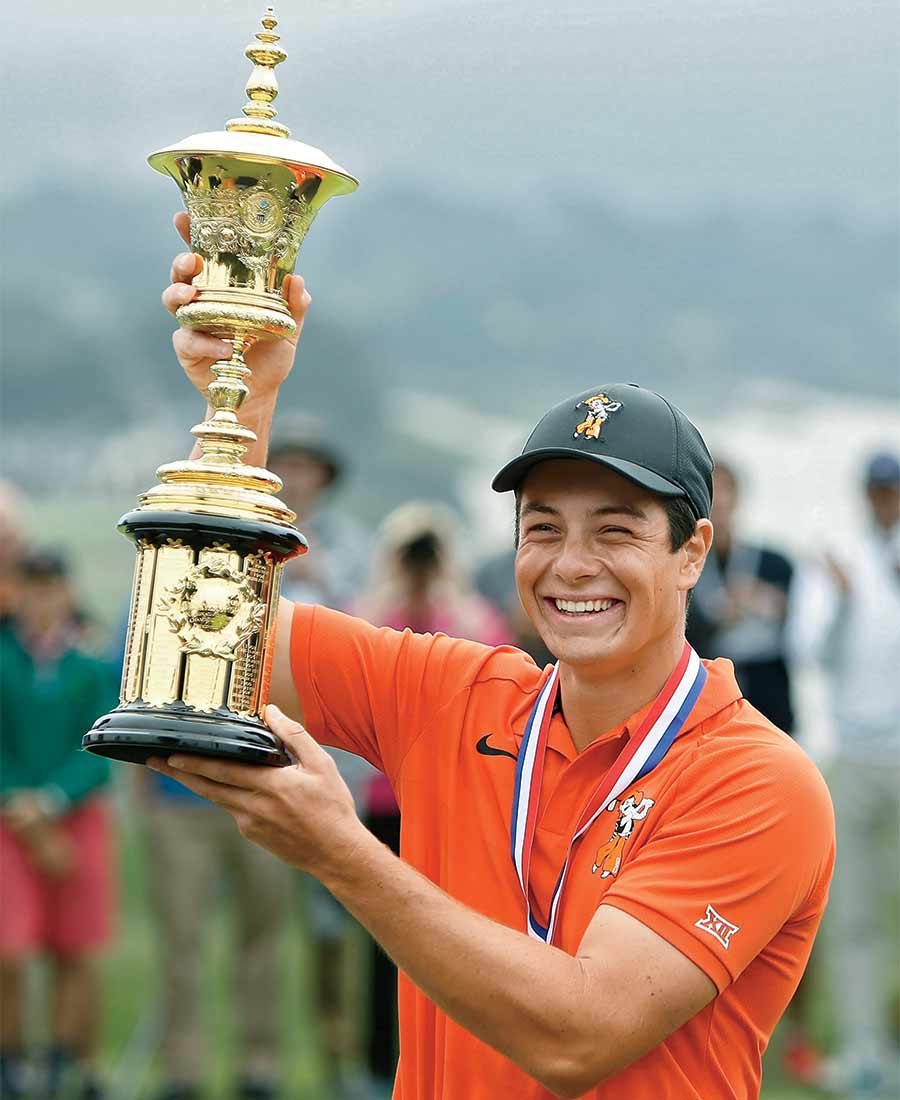
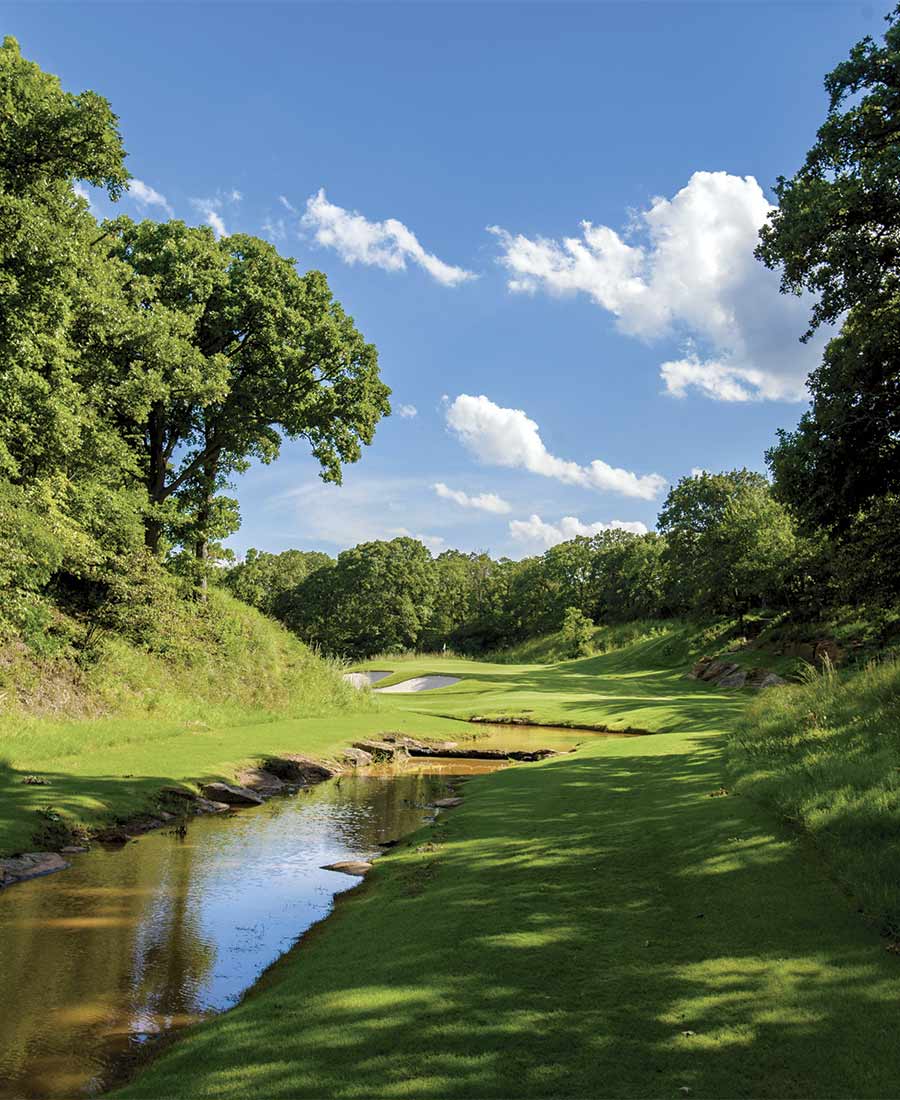
In 2016, when he arrived in Stillwater for his freshman season, Hovland adapted smoothly, aided by his countryman, Ventura, who was then a junior. If there was culture shock, it was felt mostly by other teammates, who were taken aback by Hovland’s fashion sense.
“He wore the goofiest outfits,” says fellow Cowboy Zach Bauchou, Hovland’s college roommate and now his housemate. “Things like blue pants and a red shirt. Or everything bright yellow. It was awful.”
In competition, though, Hovland fit right in. A first-team all-Big 12 pick as a freshman, he was named an all-American the following year. That summer, he ran roughshod over his opponents in the match-play portion of the 2018 U.S. Amateur at Pebble Beach. Over his last 86 holes, Hovland never trailed. In the 36-hole finals, he closed out Devon Bling 6 and 5.
Hovland’s strength has always been ball striking. But he’s pretty good at self-assessment too. After flubbing two wedge shots on his way to winning the 2020 Puerto Rico Open — the first of his two Tour victories to date — he told reporters, “I suck at chipping,” adding that he knew he needed to improve.
He has — first with assistance from the noted coach Pete Cowen and more recently through work with Jeff Smith, a Las Vegas–based instructor whom Hovland met through Bauchou’s coach, though he’d also been impressed with what he’d seen from Smith online. Since last year, Hovland’s Tour ranking in Strokes Gained: Around the Green has jumped from 168th to 101st.
Under Smith, he has fine-tuned his full swing as well, primarily by changing the amount of bend in his address, which, in turn, helps him stay more centered over the ball. The tiny tweak has paid huge dividends. Hovland now hits it farther and higher, and he has gone from a one-dimensional fader to a guy who can work the ball both ways.
In addition to golf, Hovland and Smith share a love of poker. In lessons, the coach often draws analogies to Texas Hold’em.
“I constantly remind him that he’s been dealt two kings before the flop,” Smith says. “His ball striking is so good, it’s not going to get much better. You’re not going to really change much there. But if he keeps making gains in other areas, like his short game, his fitness, his nutrition — that’s when you start talking wins in bunches, that’s when you start talking majors.”
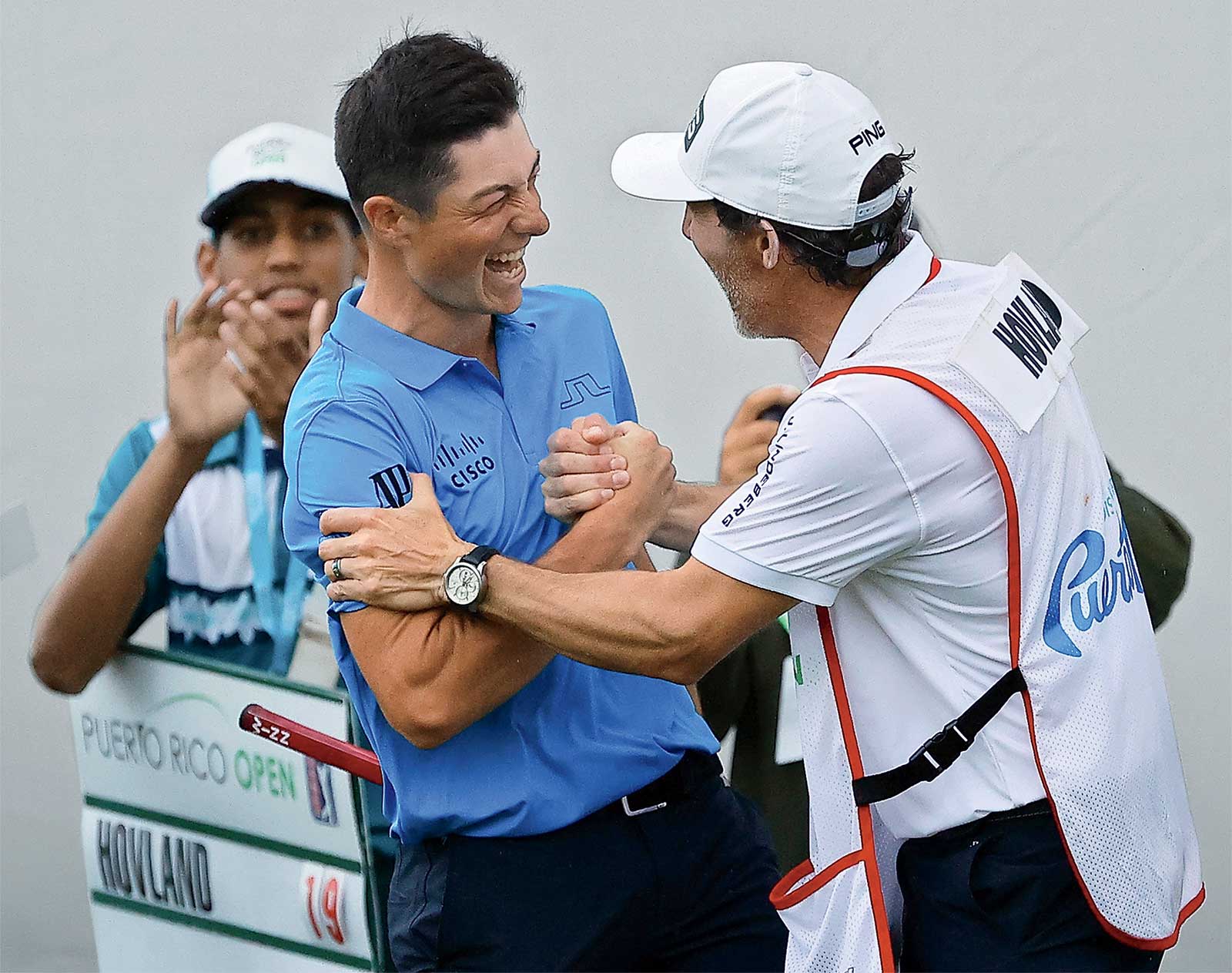
Hovland doesn’t care to forecast when that time might come. But it’s clear he’s gotten used to getting places quickly. At the start of college, before he had a car, he would walk for miles to pick up dinner at Chipotle, a practice that his teammates thought was pretty bonkers.
“I was finally like, ‘Dude, please just let me give you a ride,’” Bauchou says.
Nowadays, Hovland breezes around Stillwater in luxury wheels, swinging by Karsten Creek to play or practice, dropping by the gym to stretch or lift, enjoying the emptiness of the roads.
“Out on Tour, it’s a lot of big cities, and when you’re on the course it can be like a circus,” Hovland says. “This is the opposite of a circus. It’s just my friends, the coaches, my old teammates. It’s low-key.”
Though some folks in town recognize him from TV, everybody treats him like a local, which is how he likes it and also how he sounds. His speech has a slight twang. He says y’all. As in, “I’m hoping to kick y’alls’ butts in the Ryder Cup this fall.”
You can take the Norwegian out of Norway, but you can’t make him change his national allegiance. And you can’t make him listen to Garth Brooks.
Inside the Lexus, the windows are shaking from the strains of “Cloud Cascade,” a jarring work of discordance by Invent Animate, one of Hovland’s favorite bands.
Cacophony like this is his constant soundtrack — on the range, in the gym, as he’s drifting off to sleep. Someday, he says, he’d like to sing lead vocals in a death-metal band.
“Although I guess it would be more like screaming,” he says. “Really, I just like the mood that it creates.”
Hovland turns a corner, nearing his destination: the school’s sports training center, in the bowels of the football stadium, a place for box jumps, bench presses and the like. Once chubby, Hovland is now chiseled, with one foot still on campus but a kid no more.
In the parking lot, he kills the engine and the car falls silent. Hovland strolls off in the direction of his workout with a cowboy’s swagger, the picture of confidence and calm.
Get used to it, y’all.
